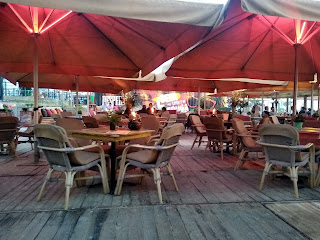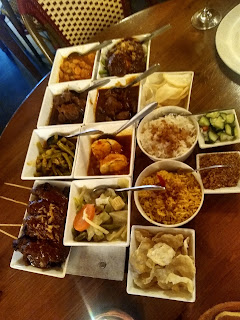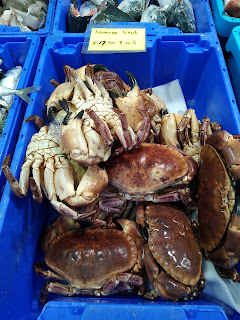
the lack of decent coffee in Brussels. Nine years later coffee bars are springing up
like mushrooms. Generally referred to as “coffee shops” to indicate that you won’t
get a Grimbergen here (although if you do it’s likely to be cheaper than a latte
macchiato) one must be careful not to confuse them with “coffee shops” over the
border in the Netherlands, which is where you don’t buy coffee - you must go to a
“coffee bar” for that. I know, it’s a minefield here in the Low Countries.
being more of a tea-drinker. I only got my first home expresso machine a couple of
months ago and am working my way through the varieties of aluminium capsule.
However, when it comes to coffee outside I knows what I likes.
The best morning (i.e. milky) coffee ever, in my humble opinion, is a Portuguese
meia-leite. Milky but strong. The perfect breakfast coffee. If you want good
coffee in Brussels without the hipsters, look for the DELTA or MELTINO logos
on the café canopies, this usually indicates that the cafe is Portuguese owned,
or at least sources their coffee from one of two reliable Portuguese coffee
companies. Pasteleria Garcia is the mecca for a meia leite and a pastel de nata.
Pace my Italian friends, but the next best coffee for me is the Spanish caffe con
leche. Again, they don’t stint on the actual coffee content. With a freshly-squeezed
zumo de naranja and a pastry, consumed at leisure in the sun under a lemon tree,
the perfect breakfast. There is no shortage of Italian coffee bars in Brussels,
particularly around the European Quarter, and if it’s a tiny hit of very strong caffeine
standing up at the bar that floats your boat early in the morning, you’re spoilt for
choice. However, an Italian once told me that the best coffee in Brussels was
from the Ethiopian coffee house.
For fans of Turkish coffee, you don’t need to go further than Little Anatolia in
Schaerbeek, where Turkish men sit calmly puffing on their shishas and sipping
the thick electric syrup, while their wives go out cleaning offices. Turkish
supermarkets sell the legal alternative to Colombian marching powder for home
brewing, as well as the little copper pots for cooking it. I recommend making it at
home if you are a woman or identify as such, Turkish cafes are very much a male
preserve.
The US East Coast coffee scene is a whole other thing. Particularly in the
aftermath of the Covid lockdown, it is the last bastion of the Hipster. I know
Hipsters have been around for a decade or more in places like New York and
London, but it's a more recent phenomenon in Belgium. They are more prevalent
in the Flemish parts of Brussels such as Dansaert but also St Gilles and the
Chatelain part of Ixelles. The new Gare Maritime complex at Tour & Taxis is
surprisingly low on baristas for the moment but give it time.
Spending time in a coffee house is not just about the coffee. In fact, it’s very
little about the coffee. It’s about the EXPERIENCE. Take a laptop even if you
are only going to faff about on Tik Tok. It indicates that you are an independent
creative and not one of those suits at the Commission. Be sure to hang out
outside of standard lunch breaks, to show that you are your own boss. Many
of the trendier coffee shops can be found near a co-working space, which is
where the more successful hipster will set up shop. Students and others often
work out of coffee shops, which, given the cost of heating right now, might not
be as pretentious as it sounds.
If you are a boomer like me, here’s how to spot a Hipster (almost exclusively male):
Aged 20 to 30. Dressed casually but expensively (particularly the shoes). Hair
expensively coiffed or tied in a man bun, sometimes covered by a knitted bonnet.
Facial hair, anything from designer stubble to full Players Navy Cut with curly
mustache (optional for females). Expensive laptop. Lily white delicate hands,
never done an honest day’s work in his life. Very slim, in order to rock skinny jeans
and skinny plain ribbed sweater. Drinking a matcha frappé or a chai latte with
almond milk. If he is eating anything, it will be organic and cereal based,
or involve quinoa. This is a growing demographic, and they are not poor, hence
the price of “speciality” coffee. The trust fund will cover any shortfall.

Such trendy coffee bars have minimalist decor - Swedish or Japanese, to aid the
concentration required for all that intense intellectual work they are doing on their
laptops - with blond wood floors, white or bare brick walls, one or two exotic plants,
some muted ambient trance music and a Swiss coffee machine that is worth more
than your house. The male baristas (like ‘barrister’ but without the years of study)
will invariably have a man bun and at least one piercing and/or tattoo. No more
“Central Perk” type comfy chairs, it will be low stools or minimalist designer chairs,
either way uncomfortable. They usually don’t take cash and are often closed in the
evening. Due to the recruitment of inexperienced youngsters post lockdown, they
may take an age to prepare your coffee, by which time it will be luke warm.
As for the bill of fare, if the café calls itself “speciality” or “specialty” coffee shop it may
have its own roastery or buy its coffee from a boutique torrefactor. It may offer a
selection of roasts from different countries in formats from straight-up to macchiato
via flat white, lungo or ristretto (the old school “lait russe” is increasingly rare), ground
specially for you on demand, with a choice of milk from cow juice to almond, coconut
and soy. They may sell beans and ground coffee on the side at eyewatering prices.
Pastries will be home made, food will be salads and tofu and easy to prepare stuff
as proper cooking is so Gen X.
I could be a bit more adventurous about my coffee drinking. In sultry Vietnam I really
enjoyed the iced coffee which you can now find in many a Vietnamese restaurant
here in Brussels. An iced coffee is a nice option on a hot day, and I must confess
to being tempted by the coconut and lemongrass latte at Stella, albeit more as a
dessert than a beverage. My benchmark when drinking coffee outside the home is
a flat white, which I discovered in London (it was invented in Australia) and which is
the nearest I’ve found to a meia-leite. I drink milky coffee before lunch and espresso
after a meal. I don’t want flavoured syrup of any kind in my coffee and I prefer the milk
to come out of a cow where possible, call me old-fashioned. (OK, Boomer).
Here is a handy guide to what to order in one of the new type of coffee bar. You don’t
want to get your doppio mocha frappuccino confused with your flat white.
:max_bytes(150000):strip_icc()/__opt__aboutcom__coeus__resources__content_migration__serious_eats__drinks.seriouseats.com__images__2013__11__20131107-latte-tulip-464c68d355e34ac1870c1230dd93e7ee.jpg)
When I was a gel, the term “speciality coffee” on a menu indicated an after-dinner
chaser made with hot coffee, alcohol and cream. The classic is the Irish Coffee,
which I learned to make when working as a waitress with my dad, an old-school
Maitre D. You need a large heavy glass three quarters full of hot strong filter coffee
sweetened with a lot of brown sugar and fortified with a good slug of Irish whiskey,
onto which you slowly pour about 2cm of chilled double cream (not whipped!) onto
the surface of the hot coffee over the back of a cold soup spoon. The finished
beverage should look like a Guinness. You can substitute other spirits for Irish
whiskey, and you drink the coffee THROUGH the cream. I have not found one
establishment, however high class, who can do this properly these days. O tempora,
o mores!
Brussels Coffee Week will be in October 2023 when you can take part in “cuppings”
(who he? - Ed.), physio workshops for baristas (!!) and latte art contests. They
provide a curated map of more than 50 trendy Brussels coffee shops some
Chains
EXKI
If you must. They are everywhere in Brussels. A kind of Belgian Pret à Manger
(although there is actually a Pret now, at Rogier) where they will do a halfway
decent macchiato or cappuccino.
PAIN QUOTIDIEN
Like Exki only with nice bread and big wooden tables.
STARBUCKS
- Pl Rogier
- Gare du Midi
- Gare Centrale
“Speciality” coffee shops
Ch de Charleroi 79
St Gilles
My Little Cup
Rue de la Croix de Fer 53
Rue de Namur 4
owned by same ppl as My Little Cup
- rue du Marché aux Poulets 49
- rue Caroly 39
The only place to my knowledge you will find the elusive Jamaican Blue Mountain roast.
Huge selection of rare and exotic coffees to drink in or buy, coffee pots and accessories.
Place Rouppe 1
Closed Sunday and Monday
Rue Ravenstein 20
Opposite Bozar
Rue Antoine Dansaert 196
Rue de la Régence 26
Opposite N.D.des Victoires church and next to the place du Petit Sablon
- rue du Bailli 7A, Chatelain
- rue Ernest Solvay 12, St Boniface
Rue de la Paix 17
St Boniface
Rue Vanderkindere 497, Uccle
Rue du Commerce 19, European Quarter
Living Room
Place Jean Rey 8
opposite Parc Léopold
- Rue du Midi 45
- Place Jourdan 13A (OR roastery)
- rue Auguste Orts 9 (next to Marriott Hotel at Bourse)
Café de la Presse
Avenue Louise 493
Natural Caffé
Avenue Louise 196A
JAT' Café
Rue de Namur 28
Chaussée de Charleroi 116
Stella Coffee Bar
Chaussée de Charleroi 91A
Wide Awake
Rue de Flandre 185
Next to Cafe Walvis by the canal
My personal recommendations
Place Colignon
next to Schaerbeek town hall - nice place to wait for your appointment at the
Commune or celebrate obtaining your residence card
Avenue de la Couronne 75-77
Meia de leite and a pastel de nata. You won’t regret it.
Galerie du Roi 3
The original Ethiopian coffee house, owned by a Finn with a deep love of Ethiopia.
Chaussée de Boondael 325
Authentic Vietnamese Caphé Sua Da - iced sweet cold drip coffee with condensed milk.
Vietnamese company Highlands Coffee now markets tins of Ca Phé Sua Da, check your
local VN food mart.


































